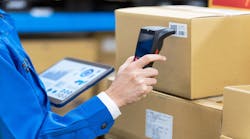As we head toward 2024, the pharmaceutical industry is at a critical juncture in its history, facing the daunting task of not only advancing science and innovation, but also safeguarding patient safety amidst the growing tide of counterfeit pharmaceutical products.
Counterfeit drugs present a multifaceted problem that demands a comprehensive and coordinated response, which is why packaging — the key touchpoint between pharma businesses and users — has a clearly defined place within this discourse.
For 2024, pharma companies need to think of packaging design as a focal point in patient security, because that’s where it truly begins. To that end, new packaging security technologies, such as micro-optics, are helping pharma companies better protect end users and patients.
The counterfeiting threat continues
Counterfeit pharmaceutical products have become a pervasive global threat, ranking as the 10th most counterfeited category of products.
These illicit drugs, often failing to meet international safety and security standards, have an estimated global value of up to $4.4 billion. Beyond the economic repercussions, the ramifications of counterfeit pharmaceuticals extend to the very core of patient safety, making it a high priority problem to solve.
In some markets around the globe, it’s estimated that around 10% of pharmaceutical products are counterfeit or illicit. Fake pharmaceuticals present a host of formidable challenges, each with far-reaching consequences — so the pharma market cannot afford to take its eye off the ball or slow down on progress.
The challenges of counterfeiting encompass economic ramifications, such as revenue losses and market distortions within the pharma industry, as well as severe health risks for patients. Illicit pharma products are not tested or regulated. Their ineffectiveness and the potential for adverse effects pose immediate threats to those in need of treatment. Moreover, counterfeit drugs can fuel drug resistance, making it harder to combat diseases at the individual level but also contribute to larger public health strategy concerns.
During pandemics and crises, counterfeit medications and vaccines can hinder collective efforts to control outbreaks, potentially leading to more extensive epidemics. Perhaps even more concerning for pharma businesses is the erosion of public trust. Counterfeit drugs undermine faith in health care systems, pharma companies and regulatory authorities, which can then translate into reluctance to seek medical care and reduced uptake rates in products such as vaccines.
Of course, these issues extend into the legal and regulatory environment, where involvement in the counterfeit drug trade carries severe legal consequences and the potential for lasting reputational damage. Furthermore, the strain on health care systems and the potential for cross-border issues amplify the global impact of this challenge, necessitating international collaboration and regulations to mitigate these risks effectively.
The protective role of packaging
In the battle against counterfeit drugs, the accelerated role of packaging and labeling technology cannot be overstated. It’s central when it comes to creating transparency, validation and safety, particularly through the more intricate and complex supply chains apparent in today’s globalized market.
Positioned at the forefront of the supply chain, pharmaceutical packaging serves to protect the efficacy and safety of medicinal products from the point of manufacture through to the hands of the end users, so naturally, we ask a lot of it in terms of performance.
Perhaps one of the most complex commercial routes today, the pharma supply chain typically includes numerous intermediaries, varying climates such as cold chain storage, and extensive transportation routes for multi-market access.
Here, we see how packaging is never ‘just’ packaging; it’s the combination of materials and designs chosen to withstand diverse environmental conditions and protect the contents from adulteration or contamination. Robust packaging materials, when coupled with intelligent design, serve to uplift and enhance the security of pharmaceutical goods in new and potentially unexpected ways.
Serialization is the most widely employed anti-counterfeiting measure in packaging and is a requirement in many geographic regions. Assigning packs their own uniquely identifiable code creates a measurable and traceable data set that can be used to track product origin.
ialization alone is no longer enough to ensure effective anti-counterfeiting, as fake products are still being identified in the market, as well as genuine products appearing in grey markets. Instead, serialization is best employed alongside other security features.
Beyond serialization
One of the clearest opportunities to accelerate the role of pharma packaging is as a tamper-evidence solution, enhancing security and providing clear validation of any tampering or unauthorized access during transit.
Regulatory compliance is everything in the highly legislated pharma landscape, and packaging is key to enabling pharma manufacturers to meet stringent regulatory initiatives, such as current good manufacturing practices (CGMP) and good distribution practices (GDP).
We have seen enormous leaps forward in the development, scalability and accessibility of technologies in tamper evidencing and authentication. These technologies offer immediate at-a-glance visual confirmation of a product’s authenticity, legality and safety, and can be effortlessly integrated into packaging.
Given the importance of flexibility in the changing pharma market, it is essential that brands consider as broad a range of anti-counterfeiting features as possible. Forensic, brand enhancement, consumer engagement and covert and overt technologies can be strategically combined with supplier expertise, allowing pharma businesses to access new tools and preserve the integrity of their products.
For 2024, pharma businesses are invited to explore security options with fresh eyes. Covert and overt security features both serve important purposes. Whereas covert features are designed for machine readability, overt features are designed for human visibility and are often the first thing we picture when thinking about anti-counterfeiting solutions. They employ visual markers and features that cannot be easily replicated by fraudsters. This can come in a number of different forms, including colorshift inks and Guilloche Print, which create intricate patterns that defy replication.
In a more complex pharma market, one standout feature that packaging providers can offer is micro-optics technology.
In fact, it’s very likely you’ve already seen this innovation in action and held it, because it’s rooted in the same technology used to safeguard the validity of valuable banknotes around the world. Micro-optics technology consists of millions of microscopic lenses, specifically shaped to focus on small, customizable icons applied to the substrate beneath them. This effect results in three-dimensional depth and movement, making it simple to quickly determine a product’s authenticity at a glance — making it an ideal fit to support drug safety, security and transparency.
With an emphasis on ease of use, micro-optics enable straightforward product authentication while allowing for designs that not only enhance security but also reinforce brand identity. Distinctive 3D effects provide clear visual indicators of authenticity, and the technology’s ability to manifest independent movement across multiple axes of tilt adds an extra layer of sophistication to product verification and security.
Micro-optic technology can be integrated with security inks, track-and-trace technologies and taggants, creating a well-rounded security ecosystem that safeguards pharma businesses against counterfeiting.
Market adoption
In part due to the continued rise of counterfeiting and the innovation seen from suppliers, the market for anti-counterfeit packaging in pharmaceuticals is witnessing remarkable growth. Projected to reach $1.8 billion by the close of 2024, market growth has been accelerated by increasing adoption of anti-counterfeiting technologies.
As the pharma industry evolves and safety concerns mount, it’s clear that packaging can assume a more prominent role in ensuring the safe and secure delivery of drug products.
In response to a growing list of challenges, a technology-driven security strategy will be key, making use of innovative solutions available in the packaging supply chain.






